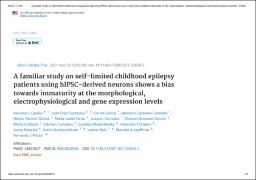A familiar study on self-limited childhood epilepsy patients using hIPSC-derived neurons shows a bias towards immaturity at the morphological, electrophysiological and gene expression levels

View/
Date
2021-11-01Author
Gonzalez, Dolores.
Córdoba, Marta.
Kauffman, Marcelo.
Et al.
Metadata
Show full item recordAbstract
Background: Self-limited Childhood Epilepsies are the most prevalent epileptic syndrome in children. Its pathogenesis is unknown. In this disease, symptoms resolve spontaneously in approximately 50% of patients when maturity is reached, prompting to a maturation problem. The purpose of this study was to understand the molecular bases of this disease by generating and analyzing induced pluripotent stem cell-derived neurons from a family with 7 siblings, among whom 4 suffer from this disease.
Methods: Two affected siblings and, as controls, a healthy sister and the unaffected mother of the family were studied. Using exome sequencing, a homozygous variant in the FYVE, RhoGEF and PH Domain Containing 6 gene was identified in the patients as a putative genetic factor that could contribute to the development of this familial disorder. After informed consent was signed, skin biopsies from the 4 individuals were collected, fibroblasts were derived and reprogrammed and neurons were generated and characterized by markers and electrophysiology. Morphological, electrophysiological and gene expression analyses were performed on these neurons.
Results: Bona fide induced pluripotent stem cells and derived neurons could be generated in all cases. Overall, there were no major shifts in neuronal marker expression among patient and control-derived neurons. Compared to two familial controls, neurons from patients showed shorter axonal length, a dramatic reduction in synapsin-1 levels and cytoskeleton disorganization. In addition, neurons from patients developed a lower action potential threshold with time of in vitro differentiation and the amount of current needed to elicit an action potential (rheobase) was smaller in cells recorded from NE derived from patients at 12 weeks of differentiation when compared with shorter times in culture. These results indicate an increased excitability in patient cells that emerges with the time in culture. Finally, functional genomic analysis showed a biased towards immaturity in patient-derived neurons.
Conclusions: We are reporting the first in vitro model of self-limited childhood epilepsy, providing the cellular bases for future in-depth studies to understand its pathogenesis. Our results show patient-specific neuronal features reflecting immaturity, in resonance with the course of the disease and previous imaging studies.
© 2021. The Author(s).
URI
https://riu.austral.edu.ar/handle/123456789/2130https://stemcellres.biomedcentral.com/articles/10.1186/s13287-021-02658-2
Collections
The following license files are associated with this item:

